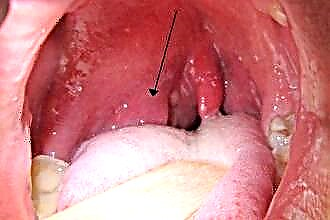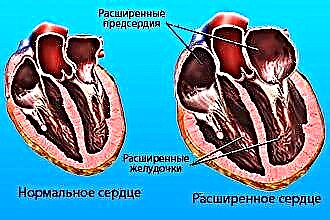A rash in the form of blisters on the surface of the mucous membrane of the mouth and throat is a sign that can seriously concern parents. If at the same time the child also becomes capricious or, conversely, lethargic, refuses to eat, is in a fever, treatment should be started. However, it is impossible to find suitable remedies without first understanding the reasons why bubbles appeared in the child's throat. You also need to remember that diseases of the oropharynx, accompanied by a blistering rash, in childhood may not occur in isolation, but in combination with other pathological conditions associated with the same pathogen.
Causes
 Diseases of the oropharynx and tonsils in children are very common - in the vast majority of cases, patients are worried about sore throat as one of the symptoms of ARVI (acute respiratory viral infection). But with classical ARVI, the picture that can be seen with pharyngoscopy (examination of the pharynx) does not include a vesicular (vesicular) rash. This symptom is typical for certain variants of lesions of the mucous membrane of the oropharynx - as a rule, of a viral nature. These include:
Diseases of the oropharynx and tonsils in children are very common - in the vast majority of cases, patients are worried about sore throat as one of the symptoms of ARVI (acute respiratory viral infection). But with classical ARVI, the picture that can be seen with pharyngoscopy (examination of the pharynx) does not include a vesicular (vesicular) rash. This symptom is typical for certain variants of lesions of the mucous membrane of the oropharynx - as a rule, of a viral nature. These include:
- Enteroviral herpangina.
- Acute herpetic stomatitis (OGS).
- Chicken pox.
In some of the listed diseases, the appearance of a rash on certain areas of the skin is also observed - for example, with chickenpox, a skin rash is one of the main criteria for confirming the diagnosis. Changes in the oropharyngeal cavity in this disease are often detected, however, they are not a mandatory sign and, due to the sequential evolution of the rash, may be represented not by bubbles, but by spots or nodules.
A rash in the form of bubbles appears when the virus fixes and multiplies in epithelial cells.
This mechanism is similar for all variants of diseases that explain the presence of vesicles in the throat. Reproduction of the pathogen occurs in the upper respiratory tract, which, as a rule, is also the "gateway" of the infection.
A blistering rash in the throat is most common in preschool and primary school children. Most infections accompanied by such a symptom are easily spread by direct contact, which is facilitated by close communication in organized and unorganized children's groups (in kindergartens, school classes, playgrounds, visiting, etc.)
When looking for the cause of the rash, you need to know that bubbles and blisters are not synonyms, but different concepts. Vesicles (vesicles) are cavity elements up to 5 mm in diameter, the opening of which, as a rule, leads to erosion on the surface of the mucous membrane or skin. A blister is an element of a rash that does not have a cavity; the size of the blister ranges from a few millimeters to several centimeters, and the appearance is due to the swelling of the papillary dermis. In the presence of blisters, one can think of the development of erythema multiforme (MEE), Stevens-Johnson syndrome.
Enteroviral herpangina
Enterovirus herpangine is spoken of when the mucous membrane of the pharynx and tonsils is affected, which is caused by Coxsackie viruses, ECHO and enteroviruses. The disease is characterized by seasonality (occurrence in summer, early autumn), mainly children under 14 years old are susceptible to pathogens.
Among the characteristics inherent in a rash on the surface of the mucous membrane of the oropharynx in the case of enteroviral herpangina, the following can be called:
- Red color.
This symptom is one of the most common, because with an infectious rash caused by other pathogens, the bubbles look different and often remain transparent.
- Small size.
The diameter of the rash elements does not exceed 5 mm, sometimes bubbles from 1 to 2 mm in size are visible.
- Localization area.
The bubbles are located on the palatine arches, tonsils, the back of the pharynx, soft palate, uvula. At the same time, there is usually no rash on the gums, which makes it possible to differentiate the manifestations of enteroviral sore throat from herpetic stomatitis.
- Consistent development.
The blistering rash does not appear immediately, the primary elements are tiny nodules that are surrounded by a red corolla. They persist only at the beginning of the disease, and subsequently, upon examination, vesicles are already detected.
- Limited duration of existence.
Vesicles on the mucous membrane usually last no longer than 2 days, and already in the first 24 hours after appearance they can transform into erosion, covered with a gray-white bloom. In general, the rash can be observed for no more than 5 or 6 days, after which the mucous membrane restores its original appearance.
 The number of bubbles in the throat of a child usually corresponds to the severity of the general condition - the more there are, the worse the patient feels.
The number of bubbles in the throat of a child usually corresponds to the severity of the general condition - the more there are, the worse the patient feels.
It should also be noted that there is no tendency to merge. On examination of the oropharyngeal cavity, the vesicles are located separately and can be painful when trying to press. When the bubbles disappear (this usually happens on the 3rd or 4th day of illness), the body temperature normalizes, and the general condition improves significantly. Erosions remaining in place of the vesicles heal quickly.
The rash appears suddenly, combined with general malaise, fever, headache, sore throat of varying severity. In children, lymph nodes enlarge, and changes in the throat may be complemented by complaints of nausea, vomiting, and abdominal pain. Sometimes signs of enteroviral herpangina are combined with symptoms of serous meningitis.
Herpetic stomatitis
OGS is associated with the herpes simplex virus. A feature is the lack of elimination (disappearance) of the pathogen from the body after recovery, while the episode of infection under the influence of contributing factors can be repeated (recurrent herpetic stomatitis). But even if there are no symptoms, the patient becomes a carrier of the virus.
The manifestations of OGS are very similar to the symptoms of enteroviral herpangina - they are united not only by the localization of the rash (mucous membrane of the oropharynx), but also by the most probable age of patients (children of early, preschool and primary school age). Therefore, a full-fledged differential diagnosis is required. On the basis of what signs can we say that we are talking about OGS? These include:
- arrangement of elements of the rash in groups;
- quickly cloudy serous exudate inside the vesicles;
- concomitant gum disease (gingivitis);
- the tendency of bubbles to merge.
Vesicles are characterized by the presence of first transparent, then cloudy contents, as well as the formation of erosions with fibrinous bloom after opening. Erosions are small, painful, rounded, can merge, often crusted. The appearance of vesicles is preceded by a rash in the form of spots.
The typical localization of the rash with OGS is the mucous membrane of the lips, cheeks, hard and soft palate, tongue. The pharynx and tonsils are rarely affected, and there is severe pain associated with the presence of bubbles and their irritation during meals. With all forms of OGS, weakness, fever, and an increase in regional lymph nodes are observed. The number of bubbles in light and medium flow forms from 3–5 and 20–25, respectively, and in severe flow it reaches 100 or more elements.
Vesicles with OGS can be located not only on the mucous membrane, but also around the mouth.
In young children, with a severe form of OGS, a bubble rash spreads to the wings of the nose, eyelids, fingers, and buttocks.The area of localization of rashes after a while ulcerates, at the peak of the increase in body temperature, new elements appear.
Since new bubbles may appear during an increase in body temperature, then with repeated examinations, several variants of changes are likely to be detected at once: spots, vesicles, and erosions (rash polymorphism). This distinguishes OGS from enteroviral herpangina, in which the rash appears at the onset of the disease and then gradually regresses without being supplemented with fresh elements.
It is worth noting that the prodromal, that is, the period preceding the stage of bright manifestations, the symptoms resemble the classic acute respiratory viral infection: weakness, fever, runny nose, coughing or coughing, impaired appetite, moodiness, tearfulness appear. Often, ARVI really becomes a primary disease, after which the condition does not improve or improves for a short time. The prodromal period is absent only with a mild form of OGS.
Chicken pox
Chickenpox is caused by the DNA-containing herpes virus type 3, which is transmitted by airborne droplets, less often by contact. The disease is characterized by:
- jerky appearance and polymorphism of the rash;
- itching of the skin in the affected area;
- the simultaneous presence of a rash on the skin;
- the presence of spots as primary elements;
- transformation of spots into nodules and bubbles.

After regression of the vesicles, no scars remain, since there is no deep necrosis.
Elements of the rash appear suddenly with fever, patients are also worried about weakness, headache. They are located on the back of the pharynx, soft palate, gums, and sometimes even on the mucous membrane of the larynx, contain a transparent serous exudate. Drying of the bubbles is accompanied by the formation of erosion, sometimes covered with crusts. Cleansing of the skin and mucous membranes occurs 7-8 days from the onset of the disease.
MEE, Stevens-Johnson syndrome
Exudative erythema multiforme is an acute skin disease, which can also be accompanied by damage to the mucous membranes (large form). Stevens-Johnson syndrome, in turn, is a variant of the course of MEE and, at the same time, a form of drug toxidermia (toxic-allergic inflammation resulting from drug intake). Sometimes its development is associated with infection (Coxsackie viruses, ECHO, herpes simplex).
The mucous membrane of the oropharynx is one of the possible lesions. Different elements of the rash appear:
- Nodes.
- Bubbles.
- Blisters.
Areas of erosion are also characteristic, on the surface of which a yellow or grayish plaque is localized. The larger the element of the rash, the greater the erosion will be after opening it; it may bleed, very painful. At the same time, the lips and gums swell, turn red, and often become covered with bloody crusts. The presence of blisters and blisters in the throat is accompanied by complaints of itching, burning, pain, young children become restless, capricious.
Rashes do not appear immediately - first, a picture of ARVI develops (weakness, cough, sore throat, fever). Only on the 4-6th day of the disease can you see reddish-cyanotic spots, nodules and nodules on the skin, as well as vesicles, blisters and blisters on the mucous membrane of the oropharyngeal cavity. The eyes and genitals are also often affected. At the same time, the cavity elements are filled with serous or bloody contents.
The appearance of bubbles and blisters in the oropharynx can be repeated in the form of seasonal attacks (in spring, autumn) over several years.
At the same time, all other symptoms characteristic of Stevens-Johnson syndrome are observed.
Regardless of the reason that caused the appearance of bubbles and / or blisters in the throat of a child, you need to see a doctor. Self-medication can aggravate the severity of pathological manifestations. A pediatrician, an infectious disease specialist, an allergist-immunologist is engaged in diagnostics and treatment.



